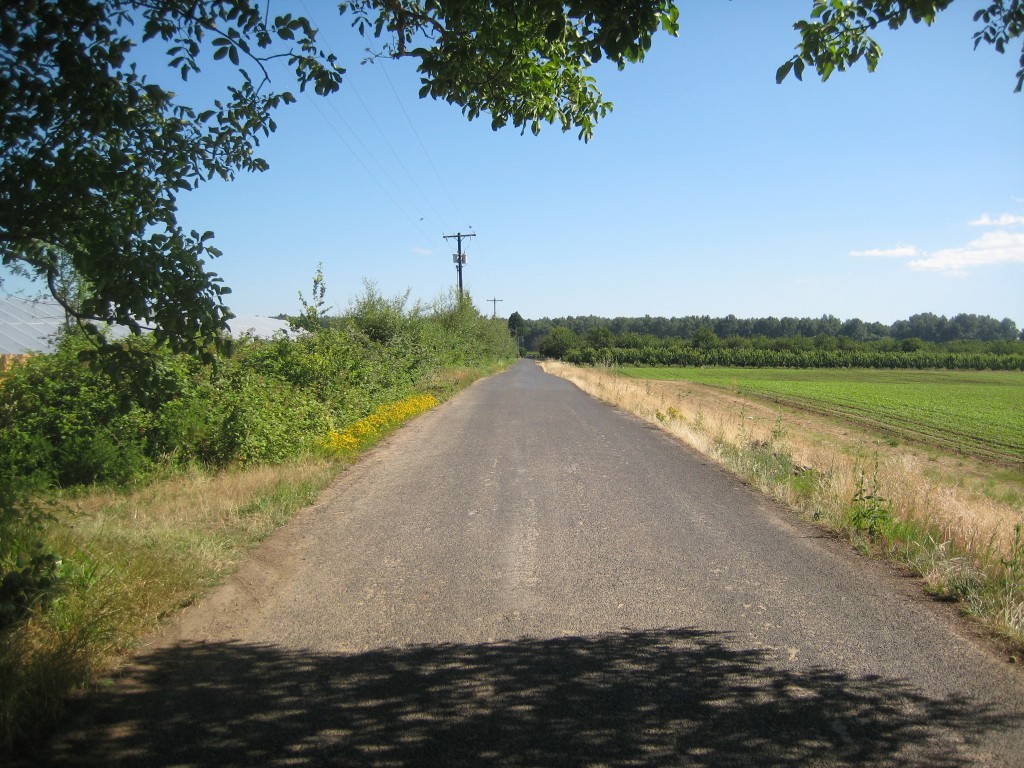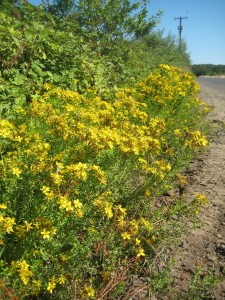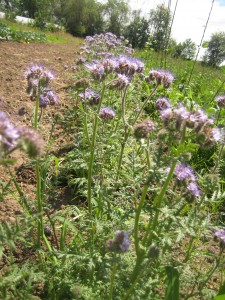
Two different farms, divided by a road. Our farm is on the left, protected from the road by a deep and tall willow/blackberry hedge that we planted seven years ago. No value judgments here — just illustrating what I write about below with a picture.
Farming is not just plain farming. It’s not as though every farmer wakes up each morning and walks out to do his or her job with the same view of how to do his or her work — or even with the same notion of what his or her work is.
Often when we talk with other farmers in our area, we realize just how deeply we approach farming with different paradigms. Our most basic assumptions start in divergent places, and we hold dear sometimes opposing values — all of which affect every major or minute decision we make … everything from what to grow, how to market, what to spray (or not), and so much more.
Our readers know this. Clearly you have done enough research about where your food comes from to understand that it is not all grown in the same way, and you have chosen to eat food grown in the way that we choose here on our farm. You value things like diverse plantings, perennial hedgerows, no spraying (not even organic-approved sprays), healthy working conditions, non-GMO seed sources, etc etc etc. All the things that are built in to the handy-dandy “organic” label (which is really quite complicated but still is a useful “shorthand” for a particular set of values about food and the environment).
One thing we have observed in our ten years farming is that our values at times bump up against other farmer’s values. Particularly in the area of how those values translate into aesthetics. What we have observed is that many larger scale farmers highly value an aesthetic of “cleanliness.” They often prefer fields free of weeds and borders that are mowed or sprayed.
This preference is not just a matter of organic vs. conventional methods, but seems to be linked to the total acres in cultivation. When a farmer is managing many larger fields, they tend to want them as tidy as possible. Certainly, there are clear arguments that can be made in favor of this aesthetic — fewer weeds means fewer plants competing for nutrients, water, sunlight, and space. Which likely translates to better yields. And of course, fewer weeds this year means fewer weed seeds that go into the weed “bank” for future years! Yes, there are many reasons to weed. True enough. That’s why it’s a Thing That Farmers Must Do.
But, I almost wonder if on that larger scale, the farmer’s brain also needs that “cleaner” aesthetic in order to “hold on” to the bigger picture of farming many large scale fields in many places. Perhaps it’s just too hard to understand the state of the crops if there are scraggly hedgerows or weeds in some of the fields.

We planted willow in our hedge, but other plants have taken root there as well, such as this stand of St. John’s Wort.
I have to admit that whether we value it or not, a “clean” aesthetic has rarely been achieved here on our farm. Many times visitors have commented (with some surprise) on the weeds in our fields. They often ask us to explain it — at times almost seeking the secret behind the weeds as though there is some mystical secret plan at work. As though we have achieved some kind of Zen master one-ness with the weeds or something, so that we have transcended the need to weed on our farm.
Far from it! We do weed, and often when people point out weeds they are looking at an older planting that is scheduled for upcoming tilling in. Because of our year-round methods, our farm is almost always in a constant state of tillage, planting, harvesting, and tilling again. Something is always going in and coming out, and certainly we give much less attention to weeding plantings that are about to be (or have just been) harvested. So, there’s always a little mess here or there.
But, we also do have different values that inspire how we prioritize our work. Perhaps to another farmer, those slightly messier older plantings would be an eyesore — something to address immediately! Again, if there is an aesthetic value of tidiness driving decisions, then yes. But always being 100% tidy on a farm is not always consistent with other possible values, such as: efficiency, profitability, farmer enjoyment, or overall vitality of a landscape.
I would say that those four values for sure trump tidiness on our farmscape. The last point is especially important to us. I have written so many times here before about our deep love for the wild. We have a deep and abiding love for the energy that is incarnated in living things, and especially in the plants we grow and the plants and animals that grow around the plants we grow. We see that the vitality on our farm, and the vitality in our food, grows as we let the edges grow and stay verdant.

Blooming phacelia in rows with our vegetables — one of our favorite flowers to plant just for the purpose of attracting beneficial insects into our fields.
From an agronomic standpoint, we also see that those “messier” areas (be they old plantings or intentionally planted perennial hedgerows) as providing necessary habitat for predatory and beneficial insects. To us, this point cannot be emphasized enough. Plants do not grow in a vacuum. They grow in soil that is hopefully alive and teeming with bacteria, fungi, and insects. They grow in air that is hopefully buzzing with insects that will provide pollination or predate on those insects that like to predate on our vegetables. When we let our edges get wild — even better, when we foster diversity and vitality through hedgerows and inter-plantings of flowers — we see our vegetables thriving, with fewer signs of insect and disease pressure. We have seen this again and again. When we fail to meet our own goals of diversity, crops suffer. It’s sort of magical and humbling and awesome all at the same time. It also allows us to grow crops and feed our community without any sprays.
Honestly, if we hadn’t been doing this work for ten years now, I’d really doubt a lot of our methods. They just don’t seem to “make sense” in conventional ways. Messier fields mean vibrant crops? Also, this year’s weird equation of having no employees and finding the work easier is surprising too. The farm has new lessons for us all the time. But, we know that much of the secret is in our scale. Being small as we are, everything we do is ultimately very human-scaled. Not just human-scaled, but family-scaled. We can watch our crops carefully and understand when and where we need to weed or mow for good productivity, but no more. All we need to are meet the needs of our community each week. We harvest, and we say: yes, this is enough. And we move into next week. That is a powerful perspective to have, and it certainly allows us plenty of wiggle room. We are never asking our land to produce As Much As It Possibly Can. We only need Enough for Us This Week.
So, visitors will probably continue to remark on our weedier spots. And neighboring farmers will probably continue to be annoyed by the “weeds” in our hedgerows. (Both types of incident happened in recent weeks.) And, I will continue to shrug in response, seeing the “mess” through the eyes, but also seeing the miracle through my own eyes. I really truly do not always understand how it works, but as each year passes, I trust more and more to the power of the land and its deeper wells of power. I trust that sometimes our vision is not the only or best one and that much can be gained by letting that wild-ness soften the edges of everything out here.
I also feel that these choices affect the food we grow. I have heard from countless CSA members over the years how their bodies feel differently when they eat our vegetables. I concur. That vitality — it’s in them too. We live on the edge out here, embracing the forces that shape us. We feel so honored to harness that power and offer it to you in vegetable form each week. May you feel deeply nourished by the food you eat from this place.
Enjoy this week’s vegetables!
Your farmers, Katie & Casey Kulla
P.S. The recent visitors who asked about the weeds were a very passionate mother-daughter team who were touring farms all over the west coast and championing food justice all the way. The daughter, Mackenzie, has kept a blog about their travels (loaded with great photos), which you can check out here : Down to Urth. I imagine that as she catches up our farm will be on there too, but given that intensity of their tour, she’s probably still processing and catching up! What an adventure!
~ ~ ~
Meet this week’s vegetables:
- Cherries — More yummy cherries! I can’t believe that we’re almost done with harvesting our Lamberts and it isn’t even July yet! We have another variety of cherries that we’ll start harvesting next week, along with the first of the plums (as soon as we can figure out how to remove that hornet nest safely … they keep coming back!)
- Salad mix
- Tomatoes
- Cucumbers
- Broccoli
- Kale
- Zucchini & summer squash
- New potatoes — A mix this week of red, purple, and purple with white interiors. All smooth fleshed new potatoes!
- Torpedo onions — Aren’t these onions just so amazing? I try to start each meal with a little onion (and/or garlic) sautéing in butter, and Rusty has begun saying the very same thing I always asked my mom when she was cooking dinner: “What smells so good?” It was always just onions/garlic in butter. But, yes my boy, that is a divine smell, and I am so glad you are appreciating it.
- Garlic — Certainly a little chopped garlic in butter is a great way to start a meal, but we’ve also been delighting in whole cloves roasted on a pan of mixed vegetables. Zucchini and garlic makes a great combination. Be sure to chop the zucchini small enough that they’ll cook through before the garlic starts to burn. High heat helps for these two items too.
~ ~ ~
And this week’s extra goodies from the farm: It’s here! Our new batch of meat! I want to point out that you’ll see some price increases here. As we work through the last of our animals (and have begun buying a bit of meat ourselves), we’ve been realizing just how very valuable this meat is. We realized that we need to at least charge what we would pay for equivalent quality retail meats elsewhere — otherwise, we might as well just put all these final animals in our freezer! But we’d rather share them with our community. So, they’re here, for all of us to share. Enjoy, enjoy, enjoy.
- Eggs — $6/dozen
- Goat — It’s here! The new batch of meat! If you’ve never tried goat meat, now is the time. Goat roasts and grind are $10/lb. Goat chops are $14/lb. Organs and bones are $6/lb.
- Beef — We have cuts! Roasts are $10/lb, and various steaks are $14/lb. Organs and bones are $6/lb.
- Ground beef — The best ever — made from a whole animal (the beef cuts we have to sell were made out of a separate portion of beef). $10/lb
- Pork organs, fat & bones — $4/lb


